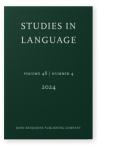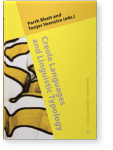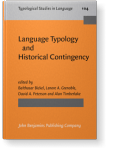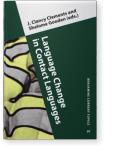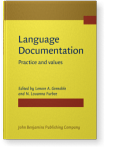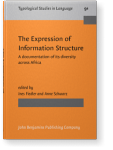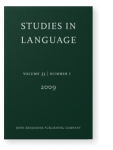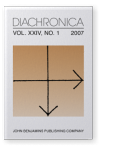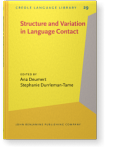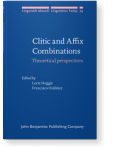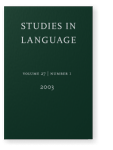Jeff Good
List of John Benjamins publications for which Jeff Good plays a role.
Journal
2013 Typologizing grammatical complexities: Why creoles may be paradigmatically simple but syntagmatically average Creole Languages and Linguistic Typology, Bhatt, Parth and Tonjes Veenstra (eds.), pp. 47–93 | Article
An important theme in work attempting to situate creoles with respect to non-creoles typologically is the extent to which it can be said that creole grammars are relatively simple from a cross-linguistic perspective. Work arguing for and against this position has generally focused on an examination… read more
2013 A (micro-)accretion zone in a remnant zone? Lower Fungom in areal-historical perspective Language Typology and Historical Contingency: In honor of Johanna Nichols, Bickel, Balthasar, Lenore A. Grenoble, David A. Peterson and Alan Timberlake (eds.), pp. 265–282 | Article
The Lower Fungom region of Northwest Cameroon is one of the most linguistically diverse areas of the Cameroonian Grassfields. Seven languages, or small language clusters, are spoken in its thirteen recognized villages. While the languages are all recognizably Bantoid, most of them do not otherwise… read more
2012 Typologizing grammatical complexities: or Why creoles may be paradigmatically simple but syntagmatically average Journal of Pidgin and Creole Languages 27:1, pp. 1–47 | Article
An important theme in work attempting to situate creoles with respect to non-creoles typologically is the extent to which it can be said that creole grammars are relatively simple from a cross-linguistic perspective. Work arguing for and against this position has generally focused on an… read more
2011 A twice-mixed creole? Tracing the history of a prosodic split in the Saramaccan lexicon Language Change in Contact Languages: Grammatical and prosodic considerations, Clements, J. Clancy and Shelome Gooden (eds.), pp. 199–238 | Article
Saramaccan, a maroon creole of Suriname, shows evidence of having a split lexicon where the majority of its words are marked for pitch accent but an important minority are marked for tone. The basic origins of this split would appear to be clear: pitch-accented words represent transfer of a… read more
2010 Valuing technology: Finding the linguist’s place in a new technological universe Language Documentation: Practice and values, Grenoble, Lenore A. and N. Louanna Furbee (eds.), pp. 111–132 | Article
Work in language documentation has forced linguists to carefully consider how new technologies can best serve the goal of preserving languages and language data. Properly addressing these concerns, however, is not simply a matter of assessing how well these technologies can serve documentary ends.… read more
2010 Topic and focus fields in Naki The Expression of Information Structure: A documentation of its diversity across Africa, Fiedler, Ines and Anne Schwarz (eds.), pp. 35–68 | Article
Naki, a mostly undescribed Bantoid language of Northwest Cameroon with svo as its canonical word order, makes use of an interesting information-structure encoding construction wherein a non-object focused element is shifted into immediately postverbal position. In this respect, Naki is similar to… read more
2009 Review of Childs (2003): An Introduction to African Languages Studies in Language 33:1, pp. 215–222 | Review
2009 A twice-mixed creole? Tracing the history of a prosodic split in the Saramaccan lexicon Language Change in Contact Languages: Grammatical and prosodic considerations, Clements, J. Clancy and Shelome Gooden (eds.), pp. 459–498 | Article
Saramaccan, a maroon creole of Suriname, shows evidence of having a split lexicon where the majority of its words are marked for pitch accent but an important minority are marked for tone. The basic origins of this split would appear to be clear: pitch-accented words represent transfer of a… read more
2006 The phonetics of tone in Saramaccan Structure and Variation in Language Contact, Deumert, Ana and Stephanie Durrleman (eds.), pp. 9–28 | Chapter
This paper presents the results of a preliminary investigation of the phonetics of tone in Saramaccan, an Atlantic creole spoken in Suriname. Two particular aspects of Saramaccan tonology are focused on (i) the ways in which a phonological split between words marked for pitch accent and words… read more
2005 Reconstructing morpheme order in Bantu: The case of causativization and applicativization Diachronica 22:1, pp. 3–57 | Article
The morphological ordering relationships among a set of valence-changing suffixes found throughout the Bantu family have been of theoretical interest in a number of synchronic studies of the daughter languages. However, few attempts have yet been made to reconstruct the principles governing their… read more
2005 Morphosyntax of two Turkish subject pronominal paradigms Clitic and Affix Combinations: Theoretical perspectives, Heggie, Lorie and Francisco Ordóñez (eds.), pp. 315–341 | Article
2003 Clause combining in Chechen Studies in Language 27:1, pp. 113–170 | Article
Chechen exhibits three major strategies for the combination of clauses: coordination, chaining, and subordination. The major formal characteristics of these three traditional categories of clause linking are discussed with reference to their basic syntax and semantics as well as to more particular… read more
